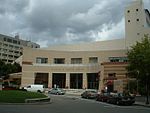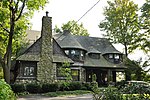Chestnut Hill, Massachusetts

Chestnut Hill is a wealthy New England village located six miles (9.7 km) west of downtown Boston, Massachusetts, United States. Like all Massachusetts villages, Chestnut Hill is not an incorporated municipal entity. It is located partially in Brookline in Norfolk County; partially in the city of Boston in Suffolk County, and partially in the city of Newton in Middlesex County. Chestnut Hill's borders are defined by the 02467 ZIP Code. The name refers to several small hills that overlook the 135-acre (546,000 m2) Chestnut Hill Reservoir rather than one particular hill. Chestnut Hill is best known as the home of Boston College and as part of the Boston Marathon route.
Excerpt from the Wikipedia article Chestnut Hill, Massachusetts (License: CC BY-SA 3.0, Authors, Images).Chestnut Hill, Massachusetts
Gate House Road, Newton Chestnut Hill
Geographical coordinates (GPS) Address Nearby Places Show on map
Geographical coordinates (GPS)
| Latitude | Longitude |
|---|---|
| N 42.330555555556 ° | E -71.166111111111 ° |
Address
Gate House Road 99
02138 Newton, Chestnut Hill
Massachusetts, United States
Open on Google Maps






